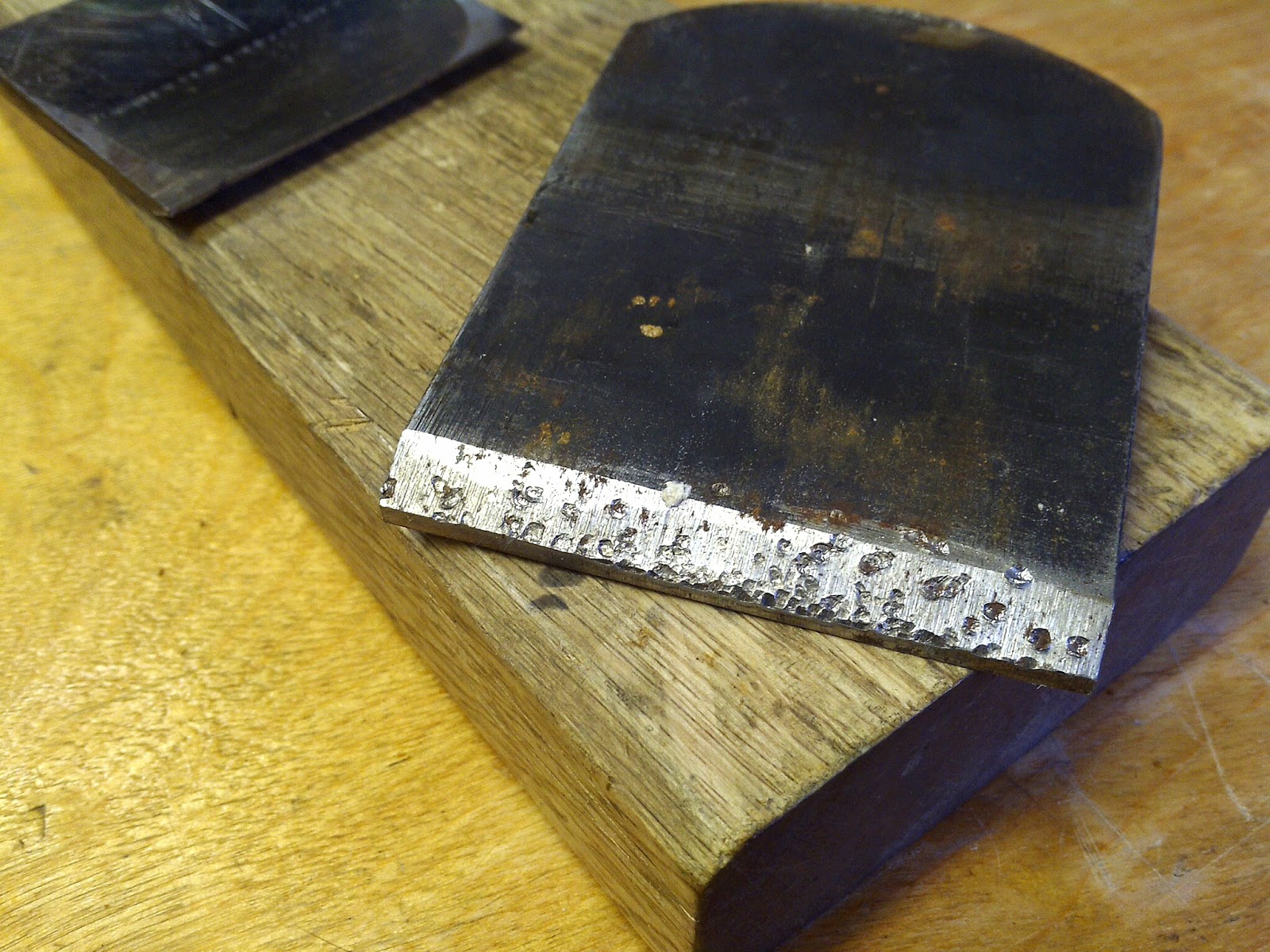More sharp!!....... Inexpensive , China made, diamond tools for sharpening the hardest Japanese tools. It's amazing how cheap ($) this stuff is getting.
I had bought a set of small detail bits suitable for a dremel type tool (1/8" shank). They worked well, and proved sufficiently durable, that I bought a larger set (1/4" shank).
 |
| Set of six, 1/4" shank, $11. |
I specifically got these for carving out profiles on some small kanna blades, used for cutting edge profiles. They seem to work just fine, the diamond grit is evenly distributed, and well adhered. If used with a light touch, these should give a respectable service life.
It’s pretty much impossible to determine *exactly* where any of these tools are made, so performance is unpredictable. At the other end of the performance spectrum are these diamond fingernail files. Diamond tools are everywhere!
 |
| 4 For $1(top), and $0.99 each (bottom) |
The upper package was found at the $Store (4 files for a dollar, I used one already.) The two at the bottom are $0.99 each at Walmart. Shockingly expensive, haha!
The $0.99 files are small, cheap ($), and cheap (quality). They work, to a limited degree, but lose their abrasive qualities rather quickly. #220 grit or so.
 |
| New on top, and after a few minutes of light work on steel (bottom). |
They would probably work just fine on fingernails, but I'm using these files for harsher duty. Japanese plane blades, high carbon steel, HSS......whatever is too hard to sharpen with a standard file.
The file on the right hand side is one of the cheapest-of-the-cheap $Store files. Larger, slightly more coarse (#180 grit), better looking and grit on all 4 sides. I was psyched to find these at the $Store, but they only had two packages remaining. I bought both!
$2 wasted! Service life can be measured in strokes, 1-2-3-done. I suspect that the file blanks are dipped in diamond fortified paint, as opposed to being electroplated. One file has a coating that stripped entirely off, after only a few minutes of VERY ineffective work.
So, from the left, we have new $0.99, used (smooth feeling) $0.99, and $0.25 $Store file.
Unfortunately, none of these are worth buying, even for a cheap guy like me.
For $11 (free delivery), these diamond files are 3" working length, come with 6 grits, and feel very durable. The electroplating, particularly on the scary rough #40 grit, is thick and holds up in use. These files work.
As the tool breaks in, more diamond surface is exposed, and the file becomes more effective. On short acquaintance, I am pleased.
I don't know much about Japanese saws, but I'm getting there. I bought a beautiful little $12, traditional 75mm yasuri feather file from eBay seller: Sakura-pink, to compare against a cheap ($11+free delivery) China-made diamond file.
 |
| Not my file-work, BTW! This saw is still fresh. |
The sizes are comparable, but the "real" file has a slightly finer profile, and is MUCH faster in use. We shall see which is longer lasting.
About 8 years ago, I bought this knife sharpener at Walmart, for about $12. It has seen VERY hard use, and still works well. Some of this cheap China stuff is pretty damn good.
All diamond tools settle in after a period of time, sometimes minutes, sometimes months. This thing mellowed out after a few weeks, but then...... just won't stop working.
Coarse on one side, fine on the other. The fine is now around #600-800 grit.
If you have some serious metal to remove, but don't have access to a grinder, here is one way to do it by hand.
This kanna blade has had some serious ura-dashi done, and needs to start looking like a cutting tool again. The flat tip is nearly 1/8" thick..... That's a lot of steel to remove!
I tape a line, to act as a guide for establishing a new bevel. Most of the material to be removed is soft iron, so I can use a standard bastard cut file to hog out the bulk of it.
I love working this soft stuff. This only takes 2 minutes.
You can hear the difference, once you get to the hard steel lamination line. Stop, before you ruin your file.
Then use the diamond file, but ONLY on the hard steel portion. I have found that soft steel and iron can strip diamonds from the file (not these, but other diamond sharpening stones, so....), so ONLY use diamond on the hardest materials.
Finally, I finish the bevel using sandpaper stuck onto glass. This establishes a final, level surface over the entire bevel.
The 3M 3X line of sandpaper comes in funny colors, and uses a ceramic abrasive that fractures down nicely in use. It lasts WAY longer than the other common abrasives (al-ox, silicone-carbide, etc.) and only cost slightly more. Money well spent.
Although this was an extreme example, this blade only took about 15 minutes to get to the stage where the sharpening part starts. That's not bad, by my book.
I could've used JUST sandpaper (the good stuff)...... Maybe 2 sheets (so, $3 for sandpaper) and 30 minutes time. It *feels * like harder work, though.












No comments:
Post a Comment
Like all of us, I am figuring this out as I go, so when you see something that is incorrect or flat out wrong (and you will!), let me know. This is a learning process. Real people and names, please. Constructive comments and questions are very welcome, but hate speak/politics are not! Life (get one!) is too short.
Thanks, Jason